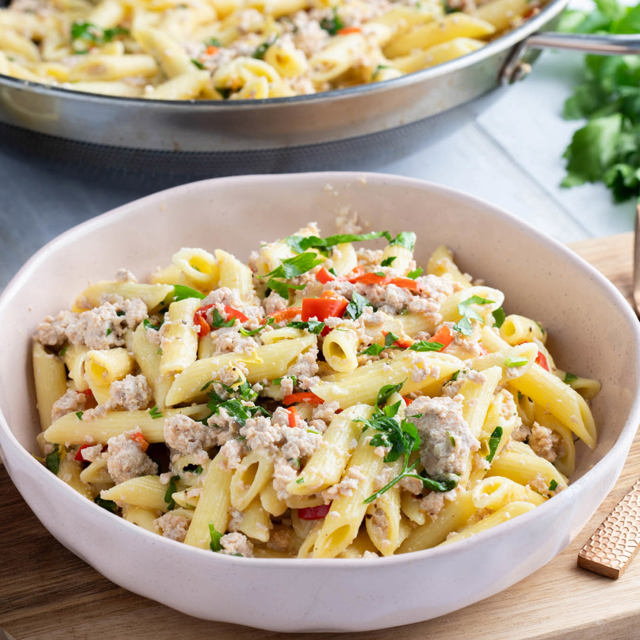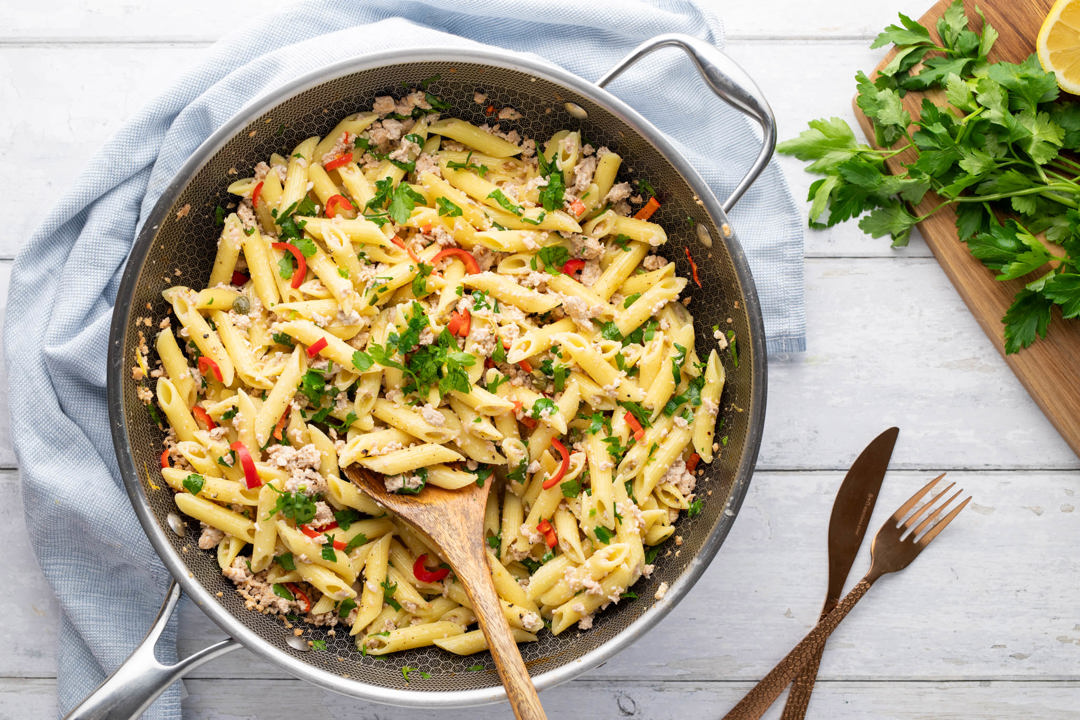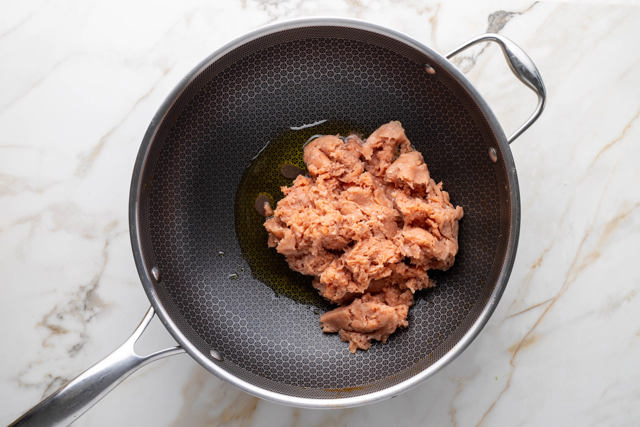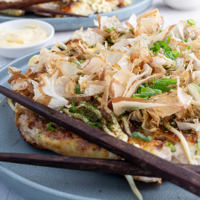This is a recipe for a quick seafood pasta that comes together in 15 minutes using fresh salmon; perfect for those busy weeknights when you want to get dinner on the table quickly and without fuss. We all know we should eat more seafood, and this is an easy way to get more in your diet with little fuss.
We try to eat seafood a few times a week, and this is a go to for us when we don’t want to put a lot of thought into it and just want to have something tasty and nutritious. We serve this with some salad greens for a complete meal.
I always keep salmon in the freezer – it freezes well – and you can make this pasta with either fillets of salmon or salmon mince; I have instructions below for both.
The flavours of this dish - capers, lemon, garlic, parsley go together well - after all, it's the core of Italian salsa verde! When combined with the salmon and pasta, a bit of cream and some wine we get some great flavours.
Salmon pasta ingredients
- Pasta – preferably penne or spirals – but feel free to use another variety if you prefer; I’d suggest something that is likely to hold the salmon to it.
- Salmon – if you can get it, salmon mince is perfect here, but you’ll probably need to go to your local fish monger to source it. Alternatively, use salmon fillets instead – skinless or not – just cook it as you normally would, and when it’s cooked through remove the skin (if present) and break it into small pieces using the bottom of your wooden spoon or turner.
- Baby capers – capers go well with seafood and lemon, it’s a classic flavour pairing. If you use salted capers, make sure you rinse and soak briefly to remove some of the excess salt. If you use regular sized capers, you might want to coarsely chop them as they can be a little large.
- Lemon – we use both the juice and the zest, so make sure you zest it before you juice it!
- Chilli – I've written the recipe to use fresh chilli, but you can easily use red pepper flakes if you prefer or skip it altogether.
- White wine pairs well with seafood. The alcohol will evaporate, but if you would prefer to leave it out you can do so - just add a splash of water instead.
- Garlic
- Parsley to finish.
How to make Salmon Pasta
Prepare ingredients - halve the chilli lengthways and use a knife or spoon to remove the membrane and seeds and then slice the chilli. Zest the lemon and mince the garlic.
Cook pasta - Start by cooking your pasta according to packet instructions, but reduce the cooking time by 1-2 minutes to keep it slightly firmer than al dente, as you'll finish cooking the pasta in the sauce.
Heat pan - while the pasta is cooking, get a large skillet and add the extra virgin olive oil and heat over a medium high heat. When the oil starts to shimmer, add your salmon.
Cook Salmon - if you’re using salmon mince, stir regularly as you would with any other type of mince until cooked through. If using salmon fillets, allow them to cook through before removing the skin (if present) and breaking them into small chunks using the back of your wooden spoon.
Add garlic and stir for about 30 seconds or until fragrant - don't allow it to colour.
Add wine if using, and allow to mostly reduce. Use your wooden spoon or turner to scrape any cooked on bits from the bottom of the skillet.
Add aromatics - add the capers, most of the chilli (reserve a little for garnishing) and lemon juice and zest and cook for a further 30 seconds.
Drain pasta - by now, your pasta should be ready to go in – you want to add it when it is still a minute or so before being cooked to al dente; use a spider, colander or strainer to remove the pasta from the pot, making sure to reserve the starchy pasta water.
Finish pasta - Add the pasta and 1/2 cup of reserved pasta water to the skillet. Stir to combine. Cook until the pasta is al dente and the sauce thickens, adding more pasta water if needed to prevent sticking.
Add cream and finish - remove from the heat and allow to cool slightly before adding the cream and parsley (1). Season to taste with salt and pepper (2) and stir to combine (3). Serve, topped with a little reserved chilli or red pepper flakes if desired.
Tips
- Salmon mince can be found at many fishmongers, but you can just as easily use fresh salmon. Just let it mostly cook through before breaking it up with your spoon.
- If you're using salted capers, rinse them before adding them to the dish. They can be very salty.
- If you're cooking salmon fillets, ask for fillets from the tail end - they'll cook quicker. They're also a more uniform thickness, so they'll cook evenly.
- Reserve more pasta water than you think you'll need - the starch in the water is key to thickening the sauce.
- If you're not using wine, a splash of fish stock can add depth to the dish.
What to serve with Salmon pasta
I like to serve this with a simple mixed green lettuce salad with a balsamic vinaigrette. You could try some of my salad recipes:
If you feel like more carbs, garlic bread always works well with pasta.
Can I use canned salmon or another type of fish?
The texture and taste of canned salmon is unsuitable for this dish. For the best result, you really should use salmon - it works particularly well due to its rich flavour and ability to hold up in the sauce.
While this recipe is designed for salmon, you could experiment with other firm, flaky fish like cod, halibut, or even trout. Keep in mind that different fish may have varying cooking times and flavours.
Salmon mince
Salmon mince is generally made from offcuts of salmon after filleting. It can be found at fishmongers, but you're able to use regular salmon if that's easier for you to source - in which case, you can use either skin on or skin off salmon.
Salmon fillets
If using skin on salmon, start cooking skin down as cooking the skin side will make it easier to peel off.
Simply cook the salmon fillet in the pan with a little oil until it's cooked through. Remove the skin, if present, and then use your turner or spoon to break the salmon into small pieces.
I suggest getting fillets from the tail end as they're thinner and generally a uniform thickness. If you have thicker fillets, they'll take longer to cook - so start the pasta later.
If you're worried about the timings when cooking whole salmon fillets, you can always cook the salmon through and remove from the heat and then start the pasta.
Make ahead, reheating and freezing
This won’t freeze well due to the cream, and fish never freezes well anyway. Leftovers can be reheated in the microwave on low to medium power level or a slow oven (around 140C) – cover your dish with foil if using the oven. Stir regularly while reheating to help prevent the cream from splitting.
Given that fish doesn't keep well, I'd suggest eating leftovers the following day.
Add your own touch
- Use different herbs, for example dill or chives.
- Try adding other vegetables such as mushrooms or spinach. If you add spinach, coarsely chop it and add it when you add the capers and chilli. If you use mushrooms, add them while cooking the salmon so that the water comes out of the mushrooms and they cook through.
- Experiment with different pasta shapes, but you'll need to use something that will hold the salmon to it for the best results.

Quick & easy creamy salmon pasta
| Prep | Cook | Total |
|---|---|---|
| 10 mins | 15 mins | 25 mins |
- 500g pasta preferably spiral or penne
- ¼ cup extra virgin olive oil
- 500g salmon fillets or mince see note 1
- 2 garlic cloves, minced
- 2 tbsp baby capers
- 2 chillies, deseeded and finely sliced see note 2
- Zest and juice of a lemon
- 125ml (1/2 cup) white wine optional - not a sweet wine. Substitute with fish stock or water if you'd prefer
- 165ml (2/3 cup) thickened cream heavy/thickened, see note 3
- Salt and pepper, to taste about 1 tsp salt, see note 4
- 20g parsley leaves, finely chopped
- Chilli/red pepper flakes to serve optional
- Cook pasta - Start by cooking your pasta according to packet instructions, but reduce the cooking time by 1-2 minutes to keep it slightly firmer than al dente, as you'll finish cooking the pasta in the sauce.
- Heat pan - while the pasta is cooking, get a large skillet and add the extra virgin olive oil and heat over a medium high heat. When the oil starts to shimmer, add your salmon.
- Cook Salmon - if you’re using salmon mince, stir regularly as you would with any other type of mince until cooked through. If using salmon fillets, allow them to cook through before removing the skin (if present) and breaking them into small chunks using the back of your wooden spoon.
- Add garlic and stir for about 30 seconds or until fragrant - don't allow it to colour.
- Add wine if using, and allow to mostly reduce. Use your wooden spoon or turner to scrape any cooked on bits from the bottom of the skillet.
- Add aromatics - add the capers, most of the chilli (reserve a little for garnishing) and lemon juice and zest and cook for a further 30 seconds.
- Drain pasta - by now, your pasta should be ready to go in – you want to add it when it is still a minute or so before being cooked to al dente; use a spider, colander or strainer to remove the pasta from the pot, making sure to reserve the starchy pasta water.
- Finish pasta - Add the pasta and 1/2 cup of reserved pasta water to the skillet. Stir to combine. Cook until the pasta is al dente and the sauce thickens, adding more pasta water if needed to prevent sticking.
- Add cream and finish - remove from the heat and allow to cool slightly before adding the cream and parsley. Season to taste with salt and pepper and serve, topped with a little reserved chilli or red pepper flakes if desired.
- Salmon - Salmon fillets (skin on or off) work fine, as does salmon mince. Salmon mince is not readily available in supermarkets in Australia, but you should be able to find it at your fishmonger. The only difference in cooking is you need to mostly cook through the salmon fillets before you break them up with the back of your wooden spoon; break them into small pieces. If you're using salmon fillets, make sure they're from the tail end as they're thinner. If you use thicker fillets, you'll need to give the salmon longer to cook before starting the pasta - you can always remove the salmon from the heat once it's cooked and then start the pasta if you're unsure of timing.
- Chilli - you can use red pepper flakes if you don’t have fresh chilli on hand. To deseed a fresh chilli, halve the chilli lengthways and use your knife or a spoon to scrape out the membrane and seeds, which is where most of the heat is.
- Cream - you can use a reduced fat cream if you want, but the texture won't be as good as using regular cream. Heavy/thickened cream is usually around 35-40% fat, which is best for this dish. You can get away with 1/3 of a cup, or add a whole cup if you really want it creamy.
- Salt - be careful adding salt, as capers can bring a lot of salt to the dish. Add it gradually, stir and adjust accordingly.
































